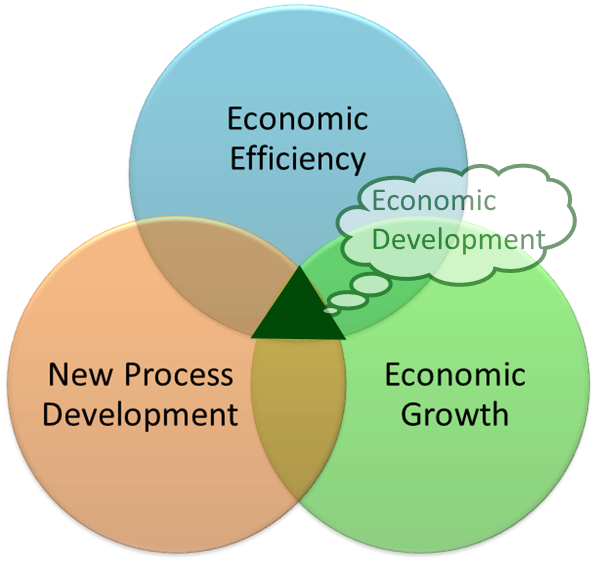 There are a lot of opinions and some misconceptions about economic development out there in popular discussion. Economic development is very important. So, we should think through how it relates to transportation infrastructure. Many people think of economic development in terms of its historic roots in real-estate development. This is only a partial and incomplete picture of a dynamic and important topic. Essentially economic development has three interrelated components:
There are a lot of opinions and some misconceptions about economic development out there in popular discussion. Economic development is very important. So, we should think through how it relates to transportation infrastructure. Many people think of economic development in terms of its historic roots in real-estate development. This is only a partial and incomplete picture of a dynamic and important topic. Essentially economic development has three interrelated components:
- Economic Efficiency – is necessary but not sufficient. This means that economic efficiency alone will not guarantee economic development. Many proponents proclaim that all you have to do is to cut out a regulation here or tax there, and you get economic development via increased efficiency. These “cut” approaches may be a good first step in cases of waste or economic distortion, but they will not necessarily guarantee growth or development. In fact, a status quo economic process that is seen as self-evidently “efficient” may suffer from a “rest on your laurels bias” and new improvements may not be pursued to a collective chorus of “if it ain’t broke don’t fix it.”
- Investments in transportation infrastructure may, on the other hand, help us become more economically efficient by allowing private sector businesses to reduce inventories, use just-In-time manufacturing approaches and better leverage logistics and supply chain efficiencies. Expanding public transit can also expand the labor pool for businesses by allowing people to get to work at an industrial park that was previously inaccessible by transit. Future automated and self-driving technologies, both passenger and freight, may have a big impact on improving economic efficiency. Along these lines, we can think of improvements in the transportation of information (i.e. broadband) as having a beneficial and complementary role to investments in physical transportation infrastructure.
- Economic Growth – is also necessary but not sufficient. Growth can come at the expense of quality of life or even economic improvement. It can be the result of everybody working longer hours and not having time for family or other pursuits. If inflation isn’t taken into account, growth can simply be the result of inflation without any real increase in goods or services. Like economic efficiency, real “inflation adjusted” economic growth can provide us the fuel we need to arrive at economic development. In this regard investments in transportation infrastructure can help us access national and global markets. One example involves pursuing a Small Community Air Service Development Program Grant to access a new air service hub such as Denver of Dallas from the Roanoke-Blacksburg Regional Airport. Another would involve developing a regional intermodal freight center to connect rail with trucks and service increased container shipments through the soon-to-be expanded Panama Canal to the Port of Virginia. This would allow us to take advantage of our geographic comparative advantages, which is a fancy way of saying further leveraging our strengths.
- New Process, Technology or Business Model Development – This is the “development” part of economic development, the secret sauce. This is where a new way of doing business or a new technology helps us become more productive. We develop new “strengths,” new comparative advantages and new industry clusters. This is often where standards of living improve. So how can transportation infrastructure help us with the “development” component of economic development? One idea is to promote the region as an urban test bed to test market new technologies such as automated vehicle systems. This would allow us to develop industry clusters around the new technologies and add new skills and strengths to a diverse regional economy. We already have the Smart Road down at the Virginia Tech Transportation Institute (VTTI). Why not extend that technology development cycle to position the Roanoke Valley as the live test bed for the next generation of transportation technologies?
So the next time that someone tells you that they have the silver bullet for economic development, you will know there is more to the story. Economic development takes long-term investments in transportation and broadband infrastructure, so that we can get to the intersection of economic efficiency, economic growth and new process development which is “Economic Development.”
